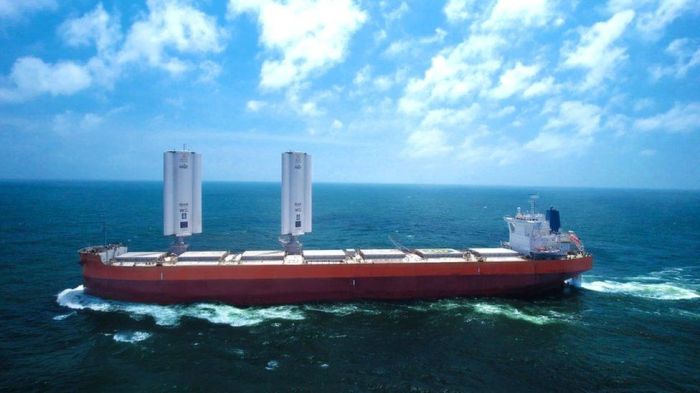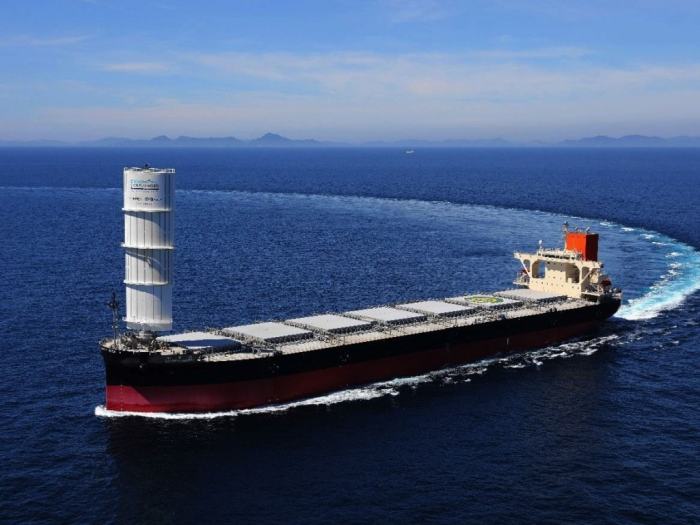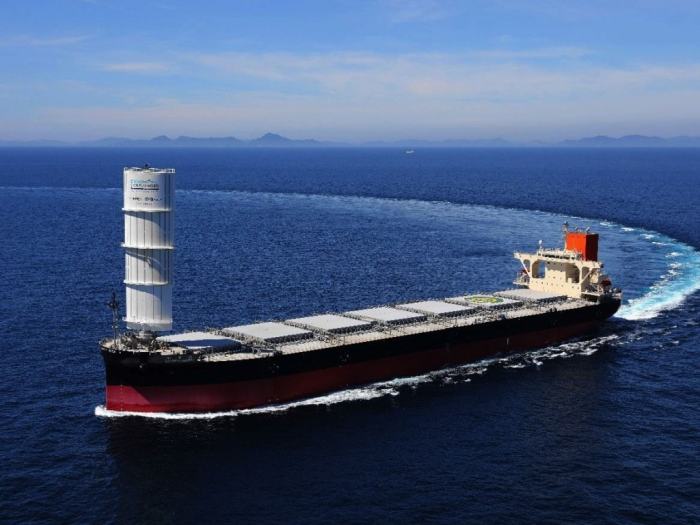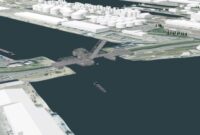Cargo ship windwings sail, a concept that might sound like something out of a sci-fi movie, is actually a cutting-edge technology revolutionizing the shipping industry. These giant sails, resembling giant wings, are designed to harness the power of the wind, propelling ships across vast distances and significantly reducing fuel consumption.
The history of windwings dates back centuries, with early versions used on sailing ships. However, modern windwing technology has evolved significantly, incorporating advanced materials and aerodynamic designs. This innovation has led to the development of windwings specifically tailored for large cargo ships, offering a sustainable and cost-effective solution to the challenges of maritime transportation.
Introduction to Cargo Ship Windwings

Cargo ship windwings are large, rigid sails that are mounted on the decks of cargo ships. They are designed to harness the power of the wind to reduce fuel consumption and emissions.Windwings are a relatively new technology, but they have the potential to revolutionize the shipping industry.
They are a cost-effective and environmentally friendly way to reduce the carbon footprint of cargo ships.
History and Evolution of Windwing Technology
The concept of using wind power to propel ships is not new. The earliest ships were powered by sails, and wind power was the primary means of transportation for centuries. However, the development of the steam engine and internal combustion engine led to the decline of sail-powered ships.In recent years, there has been a renewed interest in wind-powered ships.
This is due to the increasing concerns about climate change and the need to reduce greenhouse gas emissions. Windwings are a modern adaptation of the traditional sail, and they offer a number of advantages over traditional sails.
Benefits of Windwings for Cargo Ships
Windwings offer a number of benefits for cargo ships, including:
- Reduced fuel consumption: Windwings can reduce fuel consumption by up to 20%, depending on the size of the ship and the wind conditions.
- Reduced emissions: By reducing fuel consumption, windwings also reduce greenhouse gas emissions.
- Increased efficiency: Windwings can help to improve the efficiency of cargo ships by providing an additional source of propulsion.
- Reduced operating costs: The savings in fuel costs can lead to significant reductions in operating costs.
- Improved environmental performance: Windwings are a sustainable and environmentally friendly way to reduce the impact of shipping on the environment.
“Windwings are a cost-effective and environmentally friendly way to reduce the carbon footprint of cargo ships.”
How Windwings Work
Windwings, also known as Flettner rotors, are large, rotating cylinders that harness wind energy to propel cargo ships. These innovative sails operate on the principle of the Magnus effect, a phenomenon that generates lift force on a rotating cylinder in a moving fluid.
Aerodynamic Principles
The Magnus effect is the key to windwing functionality. When a cylinder rotates in a fluid, such as air, the fluid flow on one side of the cylinder is accelerated, while the flow on the other side is slowed down.
This difference in fluid velocity creates a pressure difference, resulting in a lift force perpendicular to the direction of the wind.
The lift force generated by a windwing is proportional to the rotational speed of the cylinder, the diameter of the cylinder, and the wind speed.
The windwing’s design incorporates a vertical axis of rotation, allowing it to capture wind from various directions. As the wind strikes the rotating cylinder, it creates a low-pressure zone on one side and a high-pressure zone on the other, resulting in a lift force that propels the ship forward.
Deployment and Retraction
Windwings are typically deployed and retracted using a hydraulic system. The system is controlled from the ship’s bridge, allowing the crew to adjust the windwing’s angle and rotational speed based on wind conditions and the ship’s course.When deploying a windwing, the hydraulic system rotates the cylinder to its desired position, aligning it with the wind direction.
Once deployed, the cylinder begins to rotate, generating lift force. To retract the windwing, the hydraulic system reverses its operation, rotating the cylinder back to its stowed position.
Windwing Designs, Cargo ship windwings sail
Different windwing designs have emerged, each with its unique advantages:
- Traditional Flettner Rotors:These are the classic windwing design, characterized by a single, large cylinder. They are relatively simple to construct and operate but may require more space on deck.
- Multiple-Cylinder Windwings:These designs utilize multiple smaller cylinders, allowing for greater flexibility in deployment and space optimization. They can be arranged in various configurations to optimize wind capture.
- Hybrid Windwings:These designs combine traditional Flettner rotors with other sail technologies, such as rigid sails or kites, to enhance efficiency and performance.
Applications of Windwings in Cargo Shipping

Windwings, also known as Flettner rotors, are a promising technology for reducing fuel consumption and greenhouse gas emissions in the shipping industry. Their application is not limited to a specific type of cargo ship; instead, they can be implemented across a wide range of vessels, offering significant environmental and economic benefits.
Types of Cargo Ships that can Utilize Windwings
Windwings are adaptable to various cargo ship types, enhancing their efficiency and sustainability.
- Container Ships:These vessels, responsible for transporting large quantities of containers across the globe, are prime candidates for windwing integration. Windwings can significantly reduce fuel consumption during long voyages, making them a cost-effective and environmentally friendly solution for container shipping.
- Bulk Carriers:Bulk carriers transport various dry cargo materials, such as grain, coal, and iron ore. Windwings can enhance their efficiency by providing supplementary propulsion, reducing fuel consumption and emissions during long journeys.
- Tankers:Tankers transport liquid cargo, including oil, chemicals, and liquefied natural gas. Windwings can help reduce fuel consumption and emissions, particularly during long-haul voyages across oceans.
- Ro-Ro Ships:Roll-on/roll-off ships transport wheeled cargo, such as cars, trucks, and trailers. Windwings can be beneficial for Ro-Ro ships, especially those engaged in long-distance voyages, as they can contribute to fuel savings and environmental sustainability.
Successful Windwing Implementations
Several shipping companies have successfully implemented windwings on their vessels, demonstrating the technology’s effectiveness in reducing fuel consumption and emissions.
- NYK Line:In 2019, NYK Line, a Japanese shipping company, installed windwings on a 14,000 TEU container ship. The company reported a significant reduction in fuel consumption, highlighting the potential of windwings for large container ships.
- Mitsubishi Corporation:In collaboration with the Japan Marine United Corporation, Mitsubishi Corporation developed and installed windwings on a 180,000 DWT bulk carrier. The windwings have contributed to fuel savings and reduced emissions, showcasing their effectiveness for bulk carriers.
Impact on Fuel Efficiency and Environmental Sustainability
Windwings offer a significant advantage in reducing fuel consumption and environmental impact in the shipping industry.
- Fuel Efficiency:Windwings provide auxiliary propulsion, supplementing the main engine and reducing fuel consumption. Studies have shown that windwings can reduce fuel consumption by 5-10% on average, depending on factors like wind speed and sailing route. This translates to substantial cost savings for shipping companies and reduced emissions.
Obtain access to europes throwing billions at quantum computers will it pay off to private resources that are additional.
- Environmental Sustainability:By reducing fuel consumption, windwings significantly decrease greenhouse gas emissions from cargo ships. This aligns with the industry’s commitment to reducing its environmental footprint and contributing to a more sustainable future. Windwings are a crucial technology for achieving these goals, promoting cleaner and more efficient shipping operations.
Economic and Environmental Implications: Cargo Ship Windwings Sail

Windwings, with their ability to harness wind power for propulsion, offer a compelling solution for reducing fuel consumption and greenhouse gas emissions in the shipping industry. This section delves into the economic and environmental implications of windwing adoption, examining the cost-benefit analysis, emissions reduction potential, and impact on the industry’s carbon footprint.
Cost-Benefit Analysis of Windwings
The economic viability of windwings hinges on a careful cost-benefit analysis. While the initial investment in windwing installation may be significant, the potential for fuel savings and reduced operational costs can provide a strong return on investment over time.
- Reduced Fuel Consumption:Windwings significantly reduce fuel consumption by harnessing wind power for propulsion, leading to substantial savings in fuel costs. This translates to a direct economic benefit for shipping companies, as fuel is a major expense in the industry.
- Lower Emissions:By reducing fuel consumption, windwings directly contribute to lower greenhouse gas emissions, aligning with the industry’s sustainability goals and reducing environmental impact.
- Increased Cargo Capacity:The reduced fuel consumption and weight of windwings can allow for increased cargo capacity on vessels, potentially leading to higher revenue generation.
- Enhanced Operational Efficiency:Windwings can contribute to smoother and more efficient operations, reducing delays and improving overall vessel performance.
The cost-benefit analysis should consider factors such as the size and type of vessel, the prevailing wind conditions in the ship’s operating routes, and the lifespan of the windwing system. A comprehensive assessment can help shipping companies determine the financial feasibility of windwing adoption.
Greenhouse Gas Emissions Reduction
Windwings play a crucial role in reducing greenhouse gas emissions from the shipping industry. By leveraging wind power, they contribute to a significant decrease in fuel consumption, leading to a reduction in CO2 emissions.
- Direct Emission Reduction:Windwings directly reduce CO2 emissions by lowering fuel consumption. Studies have shown that windwings can achieve fuel savings of up to 20%, translating to a significant reduction in CO2 emissions.
- Environmental Benefits:The reduced emissions from windwing adoption contribute to cleaner air quality and mitigate the effects of climate change, aligning with global efforts to reduce greenhouse gas emissions.
The adoption of windwings has the potential to significantly reduce the shipping industry’s carbon footprint, making it a key contributor to achieving global climate goals.
Impact on Shipping Industry’s Carbon Footprint
The widespread adoption of windwings could have a profound impact on the shipping industry’s carbon footprint, paving the way for a more sustainable and environmentally responsible future.
- Significant Carbon Reduction:With the potential to reduce fuel consumption by up to 20%, windwings can significantly contribute to reducing the shipping industry’s overall carbon footprint. This reduction in emissions is crucial for meeting global climate targets and mitigating the effects of climate change.
- Shift towards Sustainable Shipping:Windwing adoption aligns with the industry’s growing focus on sustainability and decarbonization. It demonstrates a commitment to reducing environmental impact and contributes to a more sustainable shipping sector.
- Industry-wide Transformation:As windwings become more widely adopted, they could trigger a transformation in the shipping industry, leading to a shift towards more efficient and environmentally friendly operations.
The potential impact of windwing adoption on the shipping industry’s carbon footprint is substantial, showcasing its role in driving a transition towards a more sustainable future.
Challenges and Future Prospects
While windwings hold immense potential for revolutionizing cargo shipping, they face several challenges and limitations that need to be addressed for widespread adoption. Ongoing research and development efforts are focused on overcoming these obstacles and unlocking the full potential of this innovative technology.
Challenges and Limitations
The practical implementation of windwings in the maritime industry presents several challenges. These include:
- Integration with existing vessel designs:Incorporating windwings into the existing fleet of cargo ships requires careful consideration of structural integrity, aerodynamic performance, and compatibility with existing equipment and systems.
- Reliability and durability in harsh maritime environments:Windwings need to withstand the rigors of ocean voyages, including high winds, waves, and salt spray, without compromising performance or safety.
- Operational complexity:The deployment, retraction, and maintenance of windwings require specialized expertise and procedures, which need to be integrated into the existing crew training and operations protocols.
- Economic feasibility:The initial investment in windwing technology, including design, installation, and maintenance, needs to be economically viable for shipping companies, considering the potential fuel savings and environmental benefits.
Research and Development Efforts
Significant research and development efforts are underway to overcome these challenges and enhance the performance of windwings. These include:
- Advanced materials and design:Researchers are exploring new materials and designs for windwings, such as lightweight composites and adaptive structures, to improve durability, strength, and aerodynamic efficiency.
- Improved control systems:Development of sophisticated control systems that optimize windwing deployment and performance based on real-time wind conditions and vessel dynamics is crucial for maximizing efficiency and safety.
- Integration with vessel automation:Integrating windwings with autonomous navigation systems and advanced vessel automation technologies can streamline operations, reduce crew workload, and enhance safety.
- Life cycle analysis and economic modeling:Comprehensive life cycle analyses and economic modeling are essential to assess the long-term cost-effectiveness and environmental impact of windwings compared to traditional propulsion systems.
Future Prospects
The future of windwings in maritime transportation is promising, with the potential to significantly reduce fuel consumption, emissions, and operating costs.
- Increased adoption:As research and development continue, the economic viability and operational benefits of windwings are expected to become more apparent, leading to increased adoption by shipping companies.
- Integration with other green technologies:Windwings can be effectively combined with other green technologies, such as battery-electric propulsion, biofuels, and solar power, to create a comprehensive approach to sustainable shipping.
- Role in decarbonization:Windwings are expected to play a crucial role in the maritime industry’s transition to a low-carbon future, helping to achieve ambitious emissions reduction targets and meet international regulations.
- Innovation and further development:Continued innovation in windwing technology, driven by industry collaboration and government support, will lead to even more efficient and sustainable solutions for cargo shipping.



